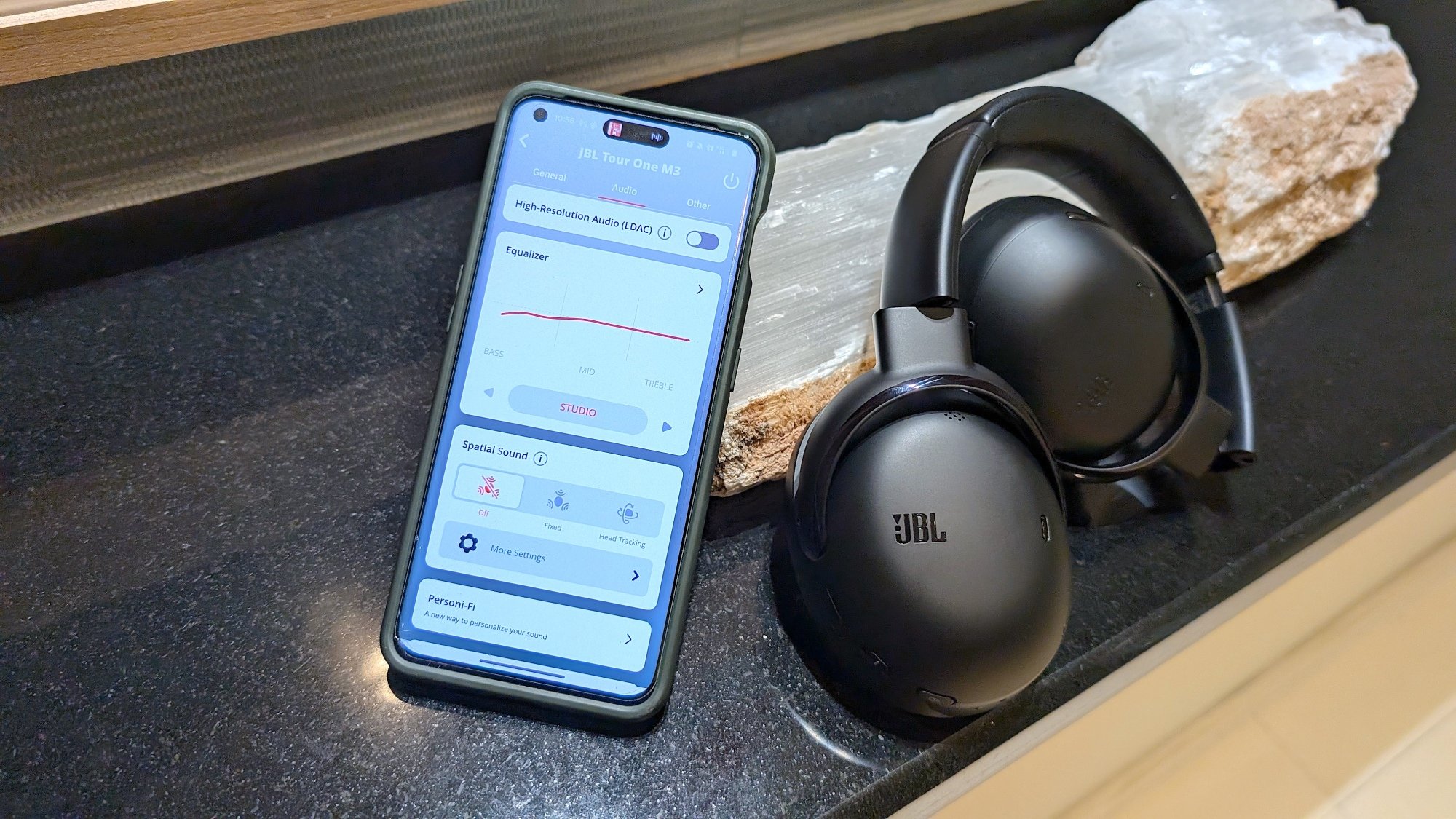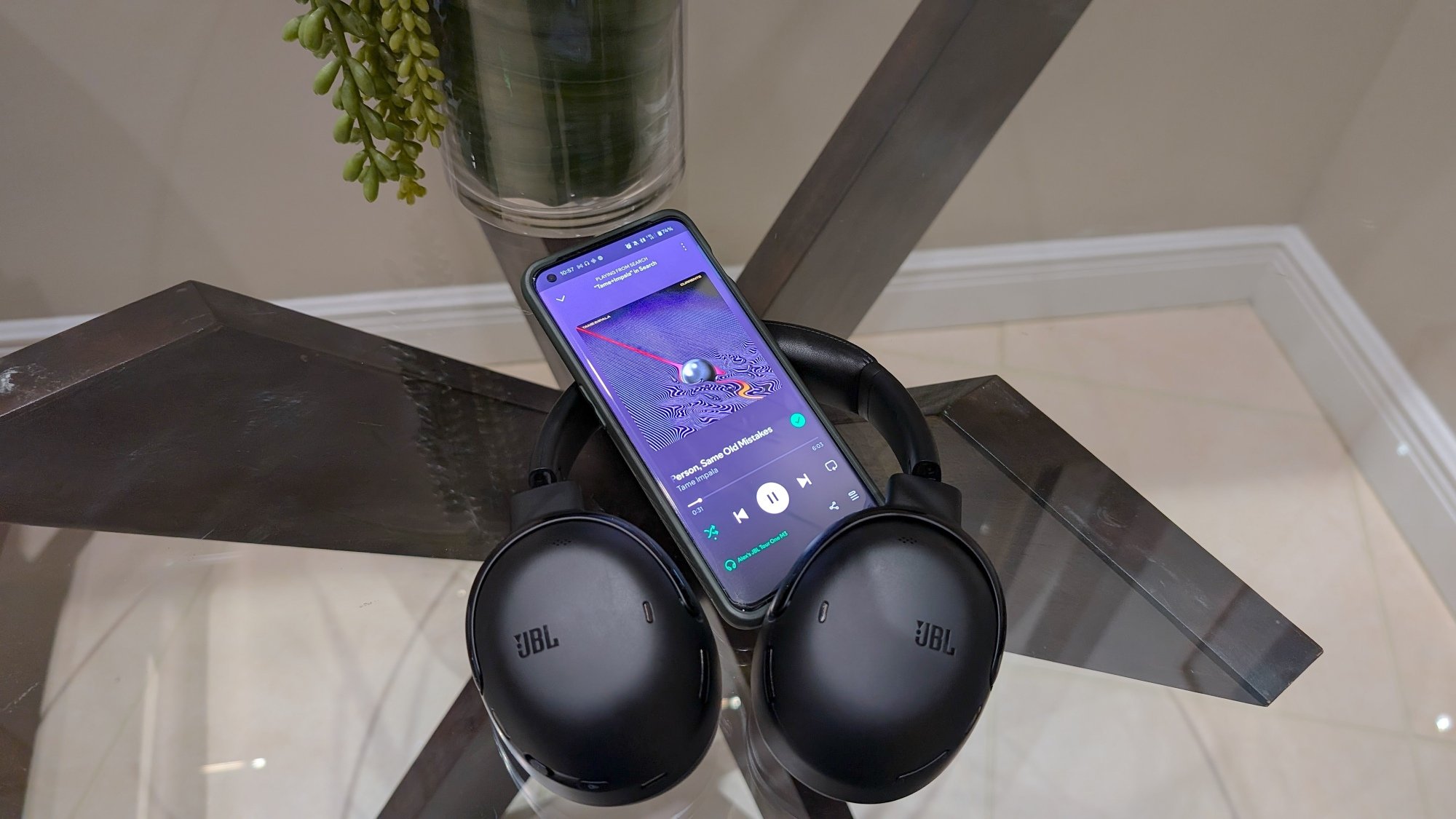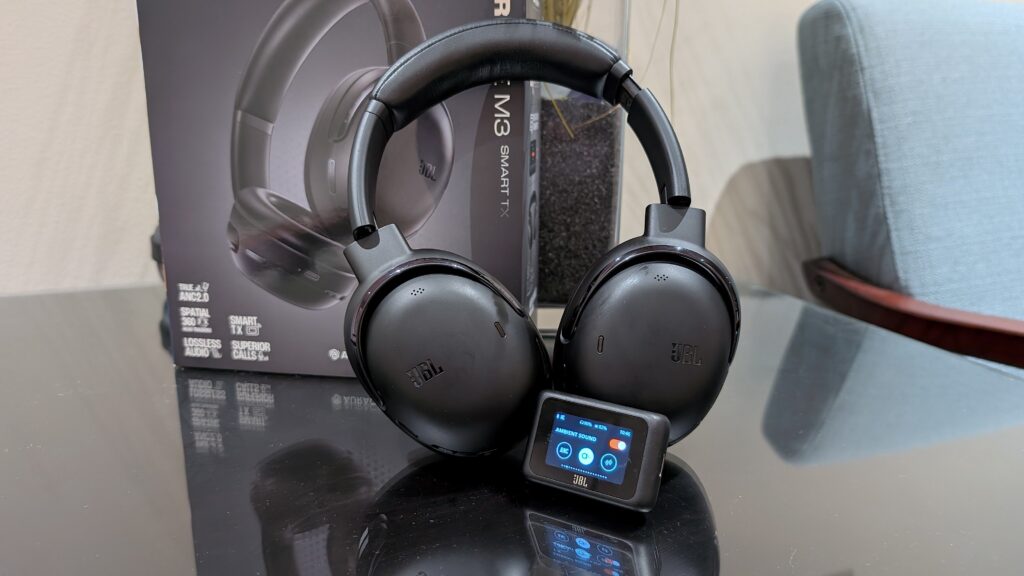
JBL has put out some of the best portable Bluetooth speakers. Its headphones and wireless earbuds are also revered by critics, though many still place the brand’s offerings a tier or two below industry favorites from Apple, Bose, and Sony. Well, the all-new Tour One M3 just changed this narrative.
These flagship cans are a noteworthy achievement in wireless audio engineering that come with every feature imaginable. I’m talking everything from adaptive active noise cancellation to intuitive sound settings to lengthy playtimes. They even come with a tiny transmitter that connects the headphones to any audio source and doubles as a remote controller.
Just because the Tour One M3 spoil you with all the functionality you could desire in a pair of wireless headphones doesn’t make them perfect. Flaws are apparent in key areas (e.g., controls, connectivity). Despite that, the Tour One M3 stand out as some of the best noise-cancelling headphones money can buy. Here are my full thoughts.
JBL Tour One M3 wireless headphones specs and setup

Credit: Alex Bracetti / Mashable
The spec sheet is stacked:
-
Speaker Driver Unit: 40mm
-
Frequency Response: 10 Hz to 40 kHz
-
True Advanced Active Noise Cancellation
-
Bundled Auracast audio transmitter (JBL Smart Tx)
-
JBL Spatial 360 Sound with headtracking
-
Personi-Fi 3.0 for audio customization
-
40 hours of battery with ANC on / 70 hours with ANC off
-
5-minute quick charging equals 5 hours of ANC listening
-
Colors: black, blue, and mocha
Pushing the toggle switch down on the right earcup will power the headphones on/off and holding it down for three seconds enables pairing mode. I connected them to my MacBook Pro by selecting the product in the Available Devices list via macOS Bluetooth settings, though the Android platform granted quicker access with one-tap Google Fast Pair.
The JBL Headphones app must be downloaded from the Apple App Store or Google Play to obtain most features. There are so many to play with that it can be overwhelming for first-timers. Those who are accustomed to menu-heavy apps will be excited to explore it.
Brand-best sound and noise cancellation
It’s no surprise that the Tour One M3 are JBL’s best-sounding and best noise-cancelling headphones to date. Dynamic components (e.g., 40mm mica dome drivers, built-in DAC), intelligible sound technologies, and real-time ANC optimization complement the listening experience, no matter where you hear your tunes.
Music sounded punchy and resonant right out of the box. The grumbling bassline on Tame Impala’s “New Person, Same Old Mistakes” produced excellent reverb that decayed smoothly, while the hazy and harmonic vocals had a euphoric presence. I dug the crisp cymbals and gritty drums on Dry Cleaning’s “Viking Hair.” Funky chill tracks like Kendrick Lamar’s “i” were serene and delivered impactful percussion that had me head-bobbing in tune with the cowbell and snare drums.
LDAC provided hi-res audio streaming over Bluetooth. Fidelity was better, and instrumental recordings had more nuance. There are other sound enhancement settings worth checking out. Equalizer hosts six well-engineered presets that cater to different categories and lets you create your own sound profile by manually adjusting frequency levels.

Credit: Alex Bracetti / Mashable
The real star of the show is Personi-Fi, a technology designed to create a sound profile based on your listening preferences. My profile performed better than all JBL presets. I enjoyed greater mids and highs that blended well with slapping lows.
JBL significantly improved its Spatial Sound mode. Sound wasn’t hollow, which has been my biggest complaint about the feature. Precise headtracking added an extra layer of realism to live performances and movies. Watching Whitney Houston’s rendition of “The Star-Spangled Banner” at Super Bowl XXV raised the hairs on my arms. Action film sequences were immersive; try watching several of the melee fights in John Wick 4 without ducking once or twice.
Other sound modes are available, but they do little to boost audio output. My ears didn’t pick up on any changes when toggling Low Volume Dynamic EQ or switching from Audio to Video mode.
Standard ANC mode is sufficient for eliminating close to 90 percent of unwanted sounds. Adaptive ANC maximizes JBL’s eight-mic array and algorithms to tweak noise neutralization on the fill. I preferred Adaptive mode for outdoor listening since it muzzled nearly all low — and mid-frequency sounds. Only a few high-frequency sounds (e.g., crying babies, sirens) entered the soundscape, though none were disruptive. Wind resistance was solid.
JBL’s transparency modes are more rewarding. Ambient Aware does a fantastic job of increasing environmental awareness. I could hear my wife calling out to me when working on the balcony, along with the water fountains and pedestrian chatter by the pool. TalkThru essentially mutes sound to hear conversations clearly. Smart Talk auto-enables TalkThru when the mics detect your voice. There’s also an amplification setting to balance ambient sound input on each earcup and increase gain for greater perception.
The most feature-stacked headphones ever created
Here I thought Sony equipped its headphones with endless features. The amount of functionality that JBL programmed into the Tour One M3 is absurd.
Enter the app, and you’re immediately met with several widgets consisting of all ANC and playback modes, control customization, smart remote settings, and toggles for sleep mode and voice prompts. The Audio section hosts many sound features, including the customizable EQ, LDAC, personalized sound profiles, spatial audio, several call settings, and more. The Other section has a Relax Sound setting to play ambient sound profiles for some peaceful time and an auto-power-off setting to preserve battery life when the headphones are inactive.
Lastly, the app lets you monitor battery life for both the headphones and transmitter.
Accessories maketh the headphones
JBL’s Smart Tx transmitter is one of those devices you didn’t know you needed until you’ve had it at your disposal. It places numerous functions in the palm of your hand, like ANC activation, Auracast transmission, Bluetooth management, EQ settings, playback, VoiceAware, volume, and plenty more. The touchscreen is responsive to touch and swipe gestures, and some of the hidden features (e.g., flashlight, notifications) are practical gems. But it’s not only about the transmitter.

Credit: Alex Bracetti / Mashable
A handful of journalists previously reported that the Tour One M2 sounded better when using the bundled aux cable. I’ve never tested that model, but I can say that the Tour One M3 sound great in wired mode. Clarity and the midrange are heightened.
There’s a USB-C to USB-C cable for charging the headphones. Let’s not forget the carrying case, which is nicely built with plenty of space on the inside to fold up and store the headphones. The huge mesh pocket on the inside holds all bundled accessories.
Comparing the JBL Tour One M3 to other headphones
I pitted JBL’s latest creation against the big three: Apple AirPods Max (2024), Bose QuietComfort Ultra, and Sony WH-1000XM5. Audio, noise cancellation, and special features are the three main hallmarks I compared.
The Tour One M3 crush the AirPods Max in sound. They also sound better than the QC Ultra, though Bose’s cans have superior spatial audio. The WH-1000XM5’s expansive soundstage and DSEE upscaling keep them in the top spot.
ANC is equally great as the AirPods Max, but less powerful than the QC Ultra and WH-1000XM5. High-frequency noises are more noticeable on the Tour One M3. Ambient listening is where JBL has an advantage over the competition. The three selectable modes — Ambient Aware, Smart Talk, and TalkThru — are effective in their purposes. I rank JBL’s transparency performance above Apple, Bose, and Sony’s based on variety alone.
Lengthy playtimes that surpass the big dogs

Credit: Alex Bracetti / Mashable
A full charge generates up to 70 hours of battery life, not factoring in ANC or special features, which decrease playtime to somewhere between 34 and 40 hours. These numbers held up during testing and outperformed Apple’s, Bose’s, and Sony’s flagship headphones. One week of moderate listening (four hours daily) and the Tour One M3 continued to operate with 10 percent left in the tank. I also spent a two-week stretch listening with ANC off and saw the battery level at 35 percent. These headphones boast some of the strongest quick-charging I’ve tested on a pair of noise-cancellers: a five-minute recharge gets you five hours of ANC listening time. It’s also worth noting that you can listen to the headphones while they recharge.
The transmitter holds 18 hours of continuous playtime and takes two hours to recharge.
Spotty connectivity, underwhelming looks, and other shortcomings
There were some hiccups with connectivity. When using the multi-point feature, the headphones paired to two devices simultaneously, but they suffered from occasional stuttering. The wireless range was weaker than expected. Audio would drop out when moving from my balcony to the bathroom (20 feet).
As much as I respect JBL’s craftsmanship, these headphones don’t look as fancy as other luxury models. The Bowers & Wilkins Px8 and Dyson OnTrac come to mind. In fact, less expensive rivals like the $199 Anker Soundcore Space One Pro look more premium.
Another issue was the control scheme. I like having physical, touch, and voice controls, but the touch controls aren’t as versatile as other headphones. The touch sensor only supports tap gestures. Models like the WH-1000XM5 support slide gestures to manage volume and skip tracks. More disappointing is the limited control customization; only the single-tap gesture can be assigned. The volume rockers on the left earcup, the ANC button on the right cup, and the transmitter remote pick up the operational slack.
Are the JBL Tour One M3 headphones worth it?
The JBL Tour One M3 are sonically satisfying, and the Smart Tx transmitter is a game-changer that every competitor will want to seriously consider when developing their next-gen headphones. Special features and playtimes also raise the Tour One M3’s stock.
However, the Tour One M3 are more expensive than Bose’s and Sony’s top entries, which sell for $100 to $180 less. The connectivity issues can be frustrating as well.
I will say that if you’re going to spend $400 on headphones, the Tour One M3 should be at the top of your list because they offer the most value. Just keep in mind that with the current economic state and tariff policies in place, pricing may go up, much like it has with other recently announced electronics (read about the Nintendo Switch 2 accessories price hike).








